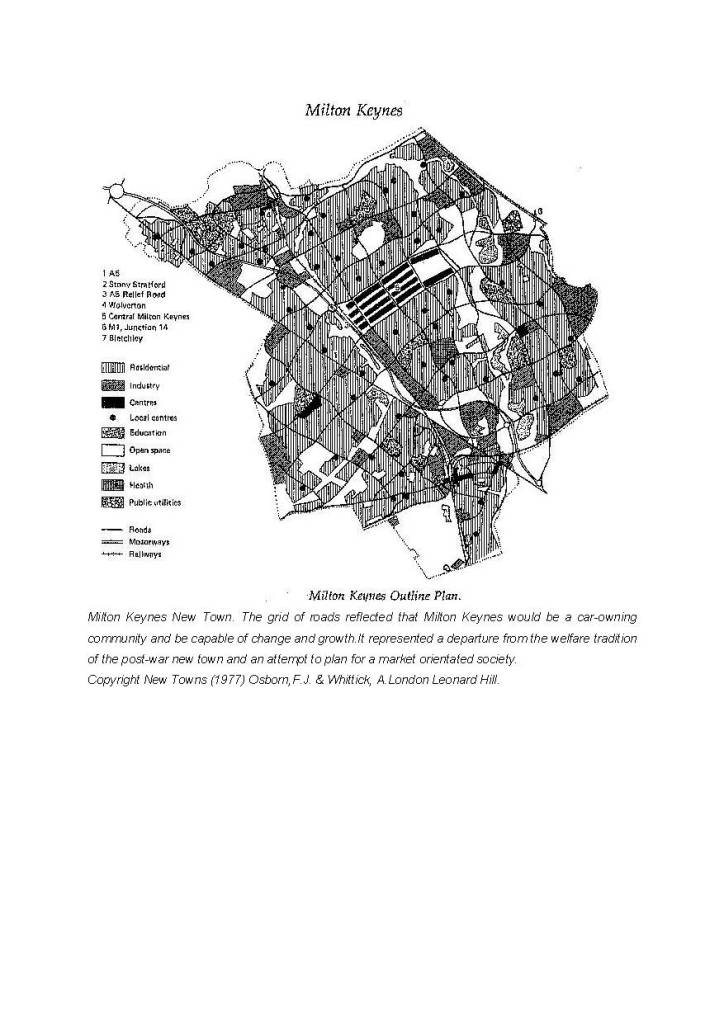Tinkering with the planning system will not solve the housing crisis. A new programme for new towns is needed.
The current approach of the government to simplify the planning process seems paradoxically to add yet another layer of complexity. Welcome though added support for brownfield development is; it has in fact been a priority for governments for more than two decades. The problem has been the added financial costs of developing these sites caused by contamination and other adverse factors. There is to be added financial support for these sites in London but this needs to be extended to the rest of the country. A more radical solution, if there are planning issues, would be to grant outline planning permission for brownfield development as an expansion of the permitted development regime.
Building on brownfield sites is only one aspect of a strategy to deal with our escalating housing problem as the country’s population edges nearer to 70 million. Governments need to recover the momentum and determination of the post–war new towns programme.
As part of the housing drive in that era, a third wave of new towns was launched in the 1960s, but they would be much larger and in some cases form expansions of existing towns. In the three years from January 1967 when he announced the designation of Milton Keynes, which was initially planned for a population of 250,000, to March 1970 just before the election, Housing and Planning Secretary Anthony Greenwood designated new towns at Peterborough, Northampton, Warrington, Telford and finally the new town centred on Preston, Leyland and Chorley This was an enormous programme and has never been equalled.

A New Town for The Arc
The recent announcement by the government that more than 150,000 homes could be built in Cambridge under the direction of a new development corporation fails to acknowledge the previous work carried out by the National Infrastructure Commission (NIC). In their report published in November 2017 on the Cambridge – Milton – Keynes Arc they summarised the opportunities for growth that the East – West Rail Link could provide. These included expansion in and around the Sandy area. Professor Emeritus Doug Clelland and I have published an article in the latest edition of Booklaunch that explores this opportunity.
It is vital that the growth of Cambridge is considered in the context of the entire Arc as recommended by the NIC. The current government proposals ignore this and instead promote an urban extension of Cambridge which would exacerbate many of the city’s existing problems as well as being a threat to the Green Belt around Cambridge.
A fuller version of the article “Creating a Heart for the Oxford- Cambridge Arc” is available as a PDF by emailing either prof.clelland@gmail.com or nigel.moor2015@gmail.com


Retiring as a county councillor at the May 2021 elections has provided me with more time to research the second edition of my book The Look and Shape of England. The new title England`s Future deals with the changes that entry into the European Union brought to England`s environment and how this will now change post-Brexit. It is to be published by Book Guild in October 2022. In tandem with this, I am publishing a regular blog dealing with these issues, which are now so important to our communities.


The publication date of England’s Future on Friday 28th October 2022 was marked by a book launch at The Old Library, Oxford University Church. Attending were friends of the author. members of GROW- the Oxford Group of Writers – and Sir Geoffrey Clifton – Brown MP for the Cotswolds and his wife Lady Kym Clifton- Brown.
Speaking at the launch Sir Geoffrey outlined the importance of good design in planning and recognized the lack of resources in local planning departments which is slowing economic growth.


Planning for the Apocalypse
Nigel Moor examines the need for resilience planning
Black Swan Events
Storm Eunice dominated the headlines for several days in February. Although the storm tore off large sections of the roof of the O2 Arena, and there was a loss of life, it, fortunately, did not have the massive impact originally feared. What it did demonstrate in London, as elsewhere in Britain, is the need to remain resilient, and to reduce the risks associated with severe weather incidents. But these are just one of a series of threats that London needs to face and plan for. It is a worryingly long list: drought, terror attack, flooding, extreme weather, infrastructure failure, disease pandemic, and cyber-attack. This last threat was the subject of a book published by former MP and Minister Oliver Letwin when he retired from parliament in 2019. Apocalypse How deals with an internet collapse and Britain`s lack of proper preparation for black swan events (unlikely but not impossible events). By only dealing with one potential event, Letwin failed to anticipate the pandemic which struck a year later, but he made some salient points about planning for resilience. To list just two. In order to avoid the collapse of the electricity grid and telecommunications, we need to maintain analog landlines Power stations need to have second alternative grid coordination. There needs to be separation from the internet.

Storm Eunice tore off large sections of the roof of the O2 Arena. Photo source PA Media.
New low-carbon energy
Much of the new low-carbon electricity generation is planned for remote or coastal areas, which means new infrastructure will be needed to bring the electricity to homes, businesses, and vehicles some distance from the source. In 2011 National Grid announced the winner of its` design competition for a new pylon design. The T -pylon designed by Bystrup, a Danish engineering company, was chosen by the judging panel as the winning design. Since National Grid has been working to ensure that the design can work in practice – for example, standing up to 80 mph winds, or the additional weight of snow in winter. The first of the pylons have been erected in Somerset to connect Hinckley Point C nuclear power station with the national grid. The new pylon allows the route of the transmission lines to follow the contours of the land rather than the sudden changes in direction that characterized the routes with lattice pylons

The T-pylon. Photograph source: Bystrup TYPLon_Id-1030×687.
London City Resilience Strategy 2020
In February 2020 just ahead of the first pandemic lock-down, the Mayor of London launched the first-ever London City Resilience Strategy to address the new and unprecedented challenges facing the capital. In researching the strategy the GLA collaborated with the 100 Resilient Cities Project which helped it gain international perspectives on resilience. Pioneered by the Rockefeller Foundation and launched in 2013, to help cities around the world become more resilient, it offers technical expertise and access to support from leading companies with the necessary expertise and capability. The strategy initially sets out the features of city resilience and then looks specifically at the long–term shocks and stresses that are likely to affect the city between now and 2050.
Some twenty-one actions are identified and an implementation programme was put forward. The urgency for this work is demonstrated by some of the key statistics set out in the report. London is the economic engine of the country accounting for 23 percent of the UK`s economic output. Every month 300 million journeys are made by public transport and just under one million bikes are hired. London is connected to the world as a centre for global trade and services, with nearly 400 international destinations served by direct connections from London airports. London already experiences threats of a disturbing magnitude. In August 2019 a major power outage affecting parts of London resulted in severe disruption to trains, the underground, and roads. It caused a brief loss of water supply to 3,000 houses.
London has already taken big steps to protect its environment. The Thames Barrier was built in 1983 to protect London from tidal surges from the North Sea. The design year was 2030 but the Environment Agency now forecasts that this can be extended to 2070. Current projections of sea-level rise give a standard of protection much higher than expected. Not originally foreseen, the barrier is increasingly used to prevent fluvial flooding in West London.

The Thames Barrier has proved its worth countless times since its installation in 1983.
London showing the way
Resilience planning offers built environment professionals an opportunity to contribute their expertise and skill to this crucial task. London is showing the way. Greater Manchester and the West Midlands are similarly developing their resilience strategies. We wait to see whether this holistic approach might be replicated at a national level.
This blog is based on my article Planning for the Apocalypse which appeared in Planning in London Issue 121 April-June 2022. See planninginlondon.com for the full article.
Levelling Up
The Levelling Up White Paper promises improved Green Belts around towns and cities, supported by Local Nature Recovery Strategies and woodland creation. My latest article in Planning in London ( Issue 120 January – March 2022) outlines how the Agriculture and Environment Acts legislated in 2020 and 2021 can deliver better public access and improved diversity in Green Belts. You can read the article at http://www.planninginlondon.com
Agriculture after Brexit
The EU`s Common Agricultural Policy (CAP) calculated subsidies by acreage which was exploited by big agribusiness that held large landholdings, but did not help the small farmers who live and work on the land. For the last 40 years, farmers have been encouraged to chase maximum yield at the expense of everything else. Leaving the EU together with an acceptance that farming must play its part in combating climate change, presents agriculture with a challenge and opportunity not seen since the end of the second world war. The National Farmers Union (NFU), which is the largest farmers` organization in the country has set an ambitious goal of reaching net-zero greenhouse gas (GHG) emissions across the whole of agriculture in England and Wales by 2040. The NFU estimate that emissions from farms amount to about one-tenth of GHG emissions.
The Agriculture Bill
Three measures are singled out by the NFU to achieve this aim. The first is improving farmers’ productive efficiency, then second to improving land management and changing land use to capture more carbon, and the thirdly boosting renewable energy and the wider bio-economy. The response of the government has been to pass into law in November 2020 the Agriculture Bill. This replaces the Basic Payments Scheme (BPS) funded under CAP with instead a system that will reward farmers and land managers with public money for “public goods. ”These include measures to improve air and water quality, enhance wildlife and soil health, reduce flooding and tackle climate change. Key to this transformational change is three new schemes that will reward environmental land management (ELM). These are:
- The Sustainable Farming Incentive
- Local Nature Recovery
- Landscape Recovery
Sustainable Farming
The schemes are intended to support the rural economy and achieve the goals of the 25- year Environment Plan introduced by Michal Gove when at the helm of DEFRA as well as the commitment to net zero emissions by 2050. The government began piloting the schemes in 2021 before they are launched in 2024. The Sustainable Farming scheme encourages farmers to specify standards for improving features such as hedgerows or grassland and payment is linked to their success in achieving these aims. Similarly, the Local Nature Recovery scheme will encourage collaboration between farmers helping them work together to agree on standards for improving their local environment.
Landscape Recovery
The Landscape Recovery scheme will support long-term projects such as restoring wilder landscapes, large–scale tree planting, and peatland and salt marsh restoration. In order to give time for framers and land managers to adapt to the new approach and consider which components of the new ELM scheme work best for their farms, direct payments will be phased out over an agricultural transition period that started in 2021 and will run until the end of 2027. One of the features of the Environment Plan is that developers are required to demonstrate a 10 % biodiversity gain when applying for planning permission. This could create a new market for farmers and landowners to offer an opportunity to secure this gain on their land.
A fundamental change to the national diet
Both the Agriculture Act and the Environment Plan provide a framework for farmers to pursue new markets for their products and their custody of our landscape. This becomes even more important if the government adopts the National Food Strategy published in July 2021 for consultation. It follows on from the initial report chaired by Henry Dimbleby who carried out a wide-ranging survey of food production and consumption. The strategy recommends a fundamental change to the national diet by 2031 to meet health, climate, and nature commitments. These would include a 30% reduction in meat consumption and an increase in consumption of fruit and vegetables 30% and a 50% increase in the consumption of fibre To ensure that British agriculture has a significant share of this reduced market for meat, customers will need to be persuaded that price cannot be the only criterion for purchase but that animal health and safety standards and environmental gains are as important.

Will a future London be levelling down?
Does Boris Johnson’s levelling-up election pledge to the Red Wall constituencies mean London faces a drastic cut in government grants?
See my article in the latest edition of Planning in London Issue 118 July-September 2021
available at http://www.planninginlondon.com
The Planning Bill
Accompanying the Queen`s Speech delivered to the Houses of Parliament on Tuesday 11th May is a lengthy briefing document running to more than one hundred and fifty pages produced by the Prime Minister`s Office. This sets out the full scope of the planning reforms to be delivered by Boris Johnson`s government.
The purpose of the Bill is to:
● Create a simpler, faster, and more modern planning system to replace the current one that dates back to 1947, and ensure we no longer remain tied to procedures designed for the last century.
● Ensure homes and infrastructure – like schools and hospitals – can be delivered more quickly across England.
● Transform our planning system from a slow document-based one to a more efficient and easier to use digital and map-based service, allowing more active public engagement in the development of their local area.
● Help deliver vital infrastructure whilst helping to protect and enhance the environment by introducing quicker, simpler frameworks for funding infrastructure and assessing environmental impacts and opportunities.
Contrary to the views expressed by many pundits before the contents of the Bill were set out, the reform of financing infrastructure is included and not left on the shelf. This inclusion is welcome and supported by many. My concern is that the controversy surrounding the other reforms will delay this necessary improvement. The Bill has many powerful critics, including the former Prime Minister Theresa May MP, which could cause considerable delay.
The Planning White Paper promised a reform of the Community Infrastructure Levy (CIL), and the current system of planning obligations by a nationally set, value-based flat rate charge (the “Infrastructure Levy”). The aim is to raise more revenue than under the current system of developer contributions, and deliver as much, if not more on-site affordable housing. Other aims are to reduce the time spent on developer negotiations involved in settling the legal s106 Agreements used to manage the payments from developers to councils. There is also a need to consider site feasibility as part of these agreements. All of this takes an inordinate amount of time and delays starts on permitted schemes.
The declared aim to be more ambitious for affordable housing provided through planning is laudable, but viability cannot be ignored. At present, particularly in two-tier council areas, the CIL system is not working for county councils, which require around eighty percent of developer contributions to finance education, transport, and other services required for the new housing. District councils that control the distribution of CIL, are prioritizing affordable housing, leaving county councils with insufficient contributions for their infrastructure. The new levy will need to resolve the problem of providing both infrastructure and affordable housing.
The “Infrastructure Levy “could be a huge step forward. The current system is not working and will frustrate the government’s ambition to reform the housing market. You could have expected this to be a top priority but burying the Levy in a whole platform of planning reforms, guarantees that it could be years before it gets onto the statute book. It needs to be un-coupled from the other planning reforms and introduced to parliament as a matter of urgency
May 22nd, 2021